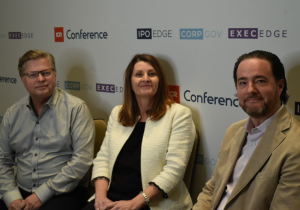
OppFi CEO Jared Kaplan
The pandemic has made access to loans more difficult for everyday consumers. That’s why OppFi, a fintech that partners with banks to offer loans to consumers with low credit scores, is seeing new demand.
The Chicago-based company is merging with FG New America Acquisition Corp. (Ticker: FGNA) , a SPAC. The combined company’s common stock is expected to trade on the New York Stock Exchange under the ticker OPFI, with the transaction expected to close by the end of the second quarter.
IPO Edge sat down with CEO Jared Kaplan to find out more about what differentiates the company from others in Fintech.
IPO Edge: What is OppFi?
We are a leading financial technology platform focused on helping millions of everyday consumers build a better financial path.
The reality is that even though the American economy operates on credit, there remains a binary: those who have credit scores above 650 and access to traditional low-interest products, and then everyone else – the 60 million Americans who are locked out of the traditional financial system. They lack access to traditional credit because of their credit score or lack of established credit, and therefore are subjected to predatory experiences that make bad situations worse. The reality of these two worlds reflects an industry ripe for disruption.
That’s where OppFi comes in; we facilitate financial inclusion by providing access to credit, blending smart underwriting technology and a customer-centric approach that provides a first-rate experience. We serve the median income U.S. consumer – someone who is employed, earns on average $50,000 per year, has access to a bank account and has limited to no savings – creating a middle ground financial service platform for a vast, underserved market.
Our mission is to help everyday consumers gain access to simple, transparent products, rebuild their financial situation and graduate back into the ecosystem of mainstream credit.
IPO Edge: There are many fintechs raising large amounts of capital and aiming to go public via SPAC, why should investors look at OppFi versus others in the space?
First, OppFi has been GAAP net income profitable since 2015, which is something that we are proud of and is a real differentiator when it comes to tech IPOs. We have proven that people can – and should be – brought under the tent of financial inclusion in a way that is both accessible and affordable. We have facilitated more than 1.5 million loans, and over the course of two years more than doubled our revenue growing from $134 million in revenue in 2018 to $323 million in revenue in 2020, while maintaining sustainable profitability.
Secondly, I believe the customer experience we deliver is one of our core competencies and investors should understand this as a competitive advantage. In a space with reputational challenges, OppFi has a thoughtful platformdesigned to disrupt the industry in a positive way by protecting consumers and leaving them better-off, with stellar customer reviews and a Better Business Bureau rating that gives us a unique “moat” in tandem with our underwriting technology. Our Net Promoter Score of 85 not only stands out among fintechs, but it is also higher than the most admired brands like Apple, Costco, USAA and Vanguard.
Third, we actually serve the everyday consumer – a large, underserved, addressable market – a large subset of which represent good risks for lenders – but only those lenders with the technology to know who that subset actually is. By having banks with low cost of capital partner with us, we can get this consumer the best product possible for their risk profile.
IPO Edge: In the past few years OppFi has grown rapidly, how does the company plan to scale as a public company?
As a public company, we believe we’ll be able to build a more robust platform for the 60 million everyday consumers in the U.S. so that we can serve as their primary financial platform. This includes continuing to develop and launch several new products currently in the pipeline like SalaryTap, an installment loan repaid through payroll deduction, and OppFi Card, a new credit card offering. OppFi Card in particular is an important product for our ecosystem because it will provide customers a next step on the path to rebuilding their financial health through access to a revolving credit product. In addition, we hope to expand into more services such as near-prime installment loans, mobile banking, point-of-sale lending, and maybe even mortgages. We believe that being a public company will help us get there, as it may facilitate OppFi’s pursuit of acquisition opportunities down the line.
In addition, we recognize the opportunity as a public company to reinvest in our own talent, which has always been a priority for OppFi. We believe that being a public company will allow us to further incentivize our employees, enabling employee growth and retention of the tremendous talent we already have.
IPO Edge: How does OppFi leverage technology to bring down underwriting costs?
Technology is central in our process of ensuring that OppFi products are affordable for each customer. Instead of focusing solely on credit score – which is not necessarily the most accurate indicator of ability and willingness to repay – we are able to analyze a number of datapoints that reflect customers’ specific situations and leverage real-time AI tools to drive automation for more than 75 percent of OppFi lending decisions.
As our business grows and we take on additional customers, our tools are collecting more data, decreasing the cost per funded loan overtime, allowing our bank partners to pass along to customers much-needed savings.
IPO Edge: How has the pandemic impacted OppFi’s business and what did you learn from that?
The typical uses for the small dollar loan product originated by FDIC-insured, state-chartered banks through our platform are to cover unexpected expenses such as car repairs and medical costs. As people stopped going out and began to quarantine, demand decreased. Initial rounds of government stimulus also served as a band-aid to replace the need for small dollar loans. And so, for the first few weeks of the pandemic, there were higher repayment rates, with many people paying down existing loans, but reduced new business. The product is something that should only be taken out if you need it.
Obviously, the pandemic was not in our plans, but we had always considered the question of how OppFi would perform amid a recession. We were founded in 2012, following the last recession, and so we approached this period as a time to prove ourselves, which we did. After the initial 90 days, we were confident that our business model would continue to perform with stability during a recession.
We realized we would be able to regain our growth trajectory as we saw that a number of the measures undertaken as a response to the pandemic and resulting recession made it more difficult for banks to identify what customers represent good credit risk. This means that even as credit scores increased, access to loans has gotten more difficult for everyday consumers over the past year, a moment in which this access is most critical. As a result, OppFi has experienced new demand from individuals who previously would have had access to credit because they were considered near prime borrowers, and our business model demonstrated its resilience.
IPO Edge: Why did OppFi decide to go public, and why through a SPAC versus traditional IPO? What led you to team up with Joe Moglia’s team rather than another SPAC?
We had been considering going public as the next step since early 2020, so this was not a sudden shift in our long-term strategy. Until now, we have built OppFi without any outside equity financing – so we grew without the fanfare that often comes off the heels of raising huge rounds of venture capital – which means there are a lot of investors who haven’t yet heard our story. As a public company, we will have more exposure to the marketplace and a chance through regular disclosures – such as the quarterly earnings call – to share the OppFi story.
By going public through a SPAC, we are able to take advantage of some price certainty and reduce exposure to some of the ambiguities beyond our control that are associated with a traditional IPO. The SPAC route also allows us to raise capital and reach public markets more quickly, allowing us to focus on developing financial inclusion products for 60 million Americans. Most importantly, this SPAC opportunity allows us to collaborate with funders who share our vision of serving everyday consumers.
In Joe Moglia and FG New America, we found partners equally committed to the tenet of high-quality customer service and meeting the needs of the millions who are locked out of traditional financial products. Joe is a leader with a proven track record of building consumer brands through people-first investments within financial services. Even though OppFi is a high-tech platform, at the end of the day, at the heart of our success, is an old-school approach to caring about the customer and providing a human-centered element of customer experience.
Contact:
Jarrett Banks, Editor-at-Large
Twitter: @IPOEdge
Instagram: @IPOEdge






